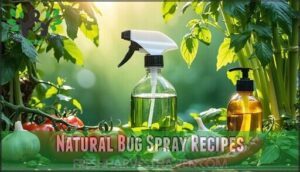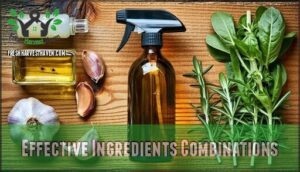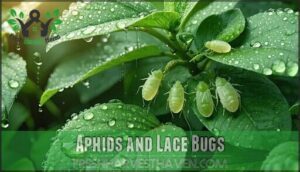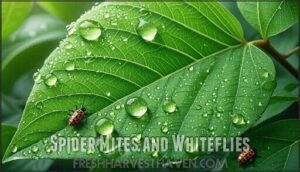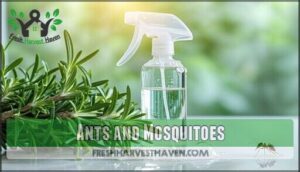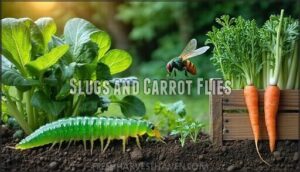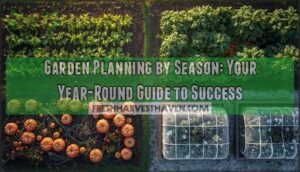This site is supported by our readers. We may earn a commission, at no cost to you, if you purchase through links.
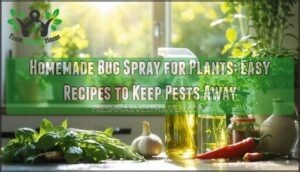 A homemade bug spray for plants is easy, safe, and surprisingly effective.
A homemade bug spray for plants is easy, safe, and surprisingly effective.
Mix one tablespoon of dish soap and one tablespoon of vegetable oil into a quart of water for a simple solution.
For a spicy twist, blend two crushed garlic cloves or a teaspoon of chili powder into the mix—pests hate the smell!
Spray this onto the leaves, focusing on the undersides where bugs hide.
Apply in the evening to avoid sunburning your plants, and reapply after rain.
It’s like giving pests an eviction notice without harmful chemicals!
Want a tip for battling specific bugs?
There’s more to explore, and finding the right method can be a simple solution.
Table Of Contents
- Key Takeaways
- Natural Bug Spray Recipes
- Effective Ingredients Combinations
- Application Methods Timing
- Targeted Pests Solutions
- Sustainable Gardening Measures
- Frequently Asked Questions (FAQs)
- What is the best homemade bug spray for plants?
- How do I make a natural insecticide for plants?
- What is the best home remedy for bugs on plants?
- How do you make bug spray for plants with Dawn?
- Can homemade sprays harm vegetable plants?
- Are homemade sprays safe for indoor plants?
- How long do sprays remain effective after mixing?
- Can homemade sprays affect soil quality?
- What spray methods reduce wastage and runoff?
- Conclusion
Key Takeaways
- Mix simple ingredients like dish soap, garlic, or chili powder for a natural bug spray.
- Apply homemade sprays in the evening, focusing on the undersides of leaves to target hiding pests.
- Always test a small area first and rinse residues to keep plants safe from potential harm.
- Reapply after rain and every 4-7 days to maintain effectiveness and control persistent pests.
Natural Bug Spray Recipes
If you’re tired of pests treating your garden like a buffet, homemade bug spray is the perfect fix.
Natural bug spray recipes are simple, effective, and safe for plant protection, making them ideal DIY insecticides. Start with dish soap and oil—mix one tablespoon dish soap with one cup vegetable oil, then dilute with warm water.
For a punchier option, try blending tomato leaves with water; their natural chemicals repel aphids and mites. Garlic-based sprays are another organic option—puree garlic, mix with vegetable oil and soap, dilute, and spray.
Nature’s chemistry lab offers its finest pest control formula: tomato leaves and garlic blended with love, delivering organic protection.
Want to deter bigger critters? A chili pepper spray might just spice up your garden defense. These natural alternatives keep pests at bay without harming your plants or the environment, using natural bug spray recipes.
Effective Ingredients Combinations
You can create powerful, natural bug sprays by combining simple ingredients like dish soap, garlic, or tomato leaves.
Each combination targets pests differently, giving you effective, affordable options for protecting your plants, with natural ingredients.
Dish Soap and Oil
Dish soap spray, combined with oil, creates an effective homemade bug spray.
Its oil smothering action suffocates pests, while the soap dehydration effect eradicates them.
Follow application best practices: test on a few leaves to guarantee plant safety, then spray thoroughly.
Don’t forget residue removal methods, like rinsing after a few days, to keep plants healthy and pest-free.
Tomato Leaves Insecticide
Tomato leaf spray offers a simple, natural pest control solution, thanks to solanine toxicity.
To prepare this homemade insecticide:
- Soak 2 cups of fresh leaves in 1 quart of water for 12 hours.
- Strain and pour into a spray bottle.
- Apply to affected plants directly.
- Target aphids and mites effectively.
Some gardeners prefer to buy premade options, while others may explore alternative recipes for broader garden pest control using natural methods.
Garlic and Soap Solutions
Garlic’s active compounds make it a powerful ally in homemade insecticide recipes.
Combine pureed garlic, vegetable oil, and soap for a soap spray that repels pests naturally.
This homemade bug spray disrupts insects while being gentle on plants.
Explore recipe variations with alternative additives like essential oils.
For application safety, test your DIY bug spray on a few leaves first.
Chili Pepper Spray Recipe
Looking for more natural pest control options? Chili pepper spray packs a punch with its pepper potency and capsaicin levels.
It’s a simple mix of hot pepper sauce, chili peppers, and liquid soap. This spray not just deters sap-sucking pests but also acts as an animal deterrent.
One can also use diatomaceous earth powder for pest control. Remember, application safety matters—test a few leaves first!
- Targets insects and animals effectively
- Uses cayenne pepper for recipe variations
- Repels rabbits and deer gently
- Eco-friendly, natural solution for gardens
This method is an eco-friendly approach to managing pests in your garden, providing a gentle yet effective way to protect your plants.
Application Methods Timing
You’ll substantially increase your homemade bug spray’s effectiveness by applying it during the evening hours when beneficial insects are less active and pests are more vulnerable.
The timing of your application, combined with proper techniques like targeting the undersides of leaves and maintaining consistent reapplication intervals, will determine whether your plants flourish or continue to struggle against unwanted visitors, which is crucial for their survival and requires proper techniques.
Evening Application
When the sun begins to set, it’s your ideal window for applying homemade bug spray to plants.
Evening application protects pollinators who’ve returned to their hives and prevents foliar damage from sunlight sensitivity.
You’ll avoid the scorching effect that occurs when spray residue magnifies sunlight on leaves.
Consistent moisture is key, so consider adjusting for rainfall to avoid overwatering.
This timing strategy guarantees your DIY insecticide works effectively without harming beneficial insects or causing plant stress.
Reapplication Intervals
Establishing proper reapplication intervals guarantees your homemade bug spray remains effective against persistent garden pests.
For maximum plant protection, consider these frequency factors:
- Reapply every 4-7 days until pest populations noticeably decrease
- Increase application frequency after rainfall or irrigation as weather impact reduces effectiveness
- Time applications to coincide with pest lifecycle stages for maximum control
To manage infestations effectively, consider purchasing garden pest solutions. Plant sensitivity and spray residue should guide your DIY bug spray schedule.
Spray Bottle Usage
A proper spray bottle transforms your homemade bug spray from merely effective to precision pest control. The right equipment guarantees even distribution and targeted application of your DIY insecticide.
Different needs require different tools, so consider various bottle styles for maximum use.
| Feature | Basic | Standard | Premium | Professional |
|---|---|---|---|---|
| Nozzle Types | Fixed spray | Adjustable | Multi-pattern | Fine mist |
| Pressure Settings | Manual | Low/High | Variable | Continuous |
| Bottle Materials | Plastic | Heavy-duty plastic | Glass | Chemical-resistant |
| Cleaning Methods | Rinse | Soap wash | Vinegar soak | Complete disassembly |
Clean your bottle after each use to prevent clogging and guarantee safe storage.
Full Strength Application
Now that you’ve got your spray bottle ready, you’ll want to apply your homemade bug spray at full strength for maximum effectiveness. Unlike commercial pesticides that require dilution, homemade insecticides work best when applied undiluted directly to affected plants.
- Your plants will thank you with vibrant, pest-free growth once they’re freed from those tiny invaders
- Watch with satisfaction as aphids retreat from your prized roses within hours
- Feel the pride of protecting your garden without harsh chemicals
- Experience the peace of mind knowing exactly what’s touching your food plants
When using direct application techniques with your homemade insecticide, target both the tops and undersides of leaves where pests hide. Monitor for potential leaf burn with dishwashing soap solutions, especially on sensitive plants. The immediate results of undiluted sprays make the concentration effects worth it, providing vibrant, pest-free growth and allowing you to protect your garden without harsh chemicals, giving you satisfaction as aphids retreat.
Targeted Pests Solutions
You’ll find specific solutions for each garden invader, from aphids munching on your roses to slugs stealing your strawberries, in this targeted section.
Whether you’re battling spider mites on your houseplants or deterring carrot flies from your vegetable patch, these customized homemade sprays will help you reclaim your garden without harsh chemicals.
Aphids and Lace Bugs
Now that you know when to apply your homemade solutions, let’s target specific pests.
Aphids and lace bugs can turn your thriving plants into wilting victims overnight.
These tiny terrors often develop spray resistance to commercial products, but your DIY bug spray offers natural defenses.
Mix 1 tablespoon mild soap with 1 quart water for a solution that suffocates aphids on contact.
For stubborn lace bug damage, add 1 teaspoon neem oil to boost effectiveness, creating a powerful tool against these tiny terrors.
Spider Mites and Whiteflies
While aphids may steal the spotlight, spider mites and whiteflies can devastate your plants just as quickly. These tiny terrors are notorious for developing spray resistance, making rotation essential.
For effective control:
- Mix 1 tablespoon neem oil with 1 teaspoon mild soap in 1 liter water
- Apply to leaf undersides where these pests hide
- Introduce natural predators like ladybugs for long-term prevention
Mite identification is vital—look for fine webbing and stippled leaves before damage becomes irreversible. Maintaining high humidity levels can also help deter spider mites.
Ants and Mosquitoes
Pesky invaders like ants and mosquitoes can wreak havoc on your garden sanctuary.
You’ll find vinegar efficacy unmatched when mixed with water and dish soap for ant prevention. For mosquitoes, eliminate standing water and surround your garden with repellent plants.
| Pest Type | Homemade Bug Spray | Pantry Staples |
|---|---|---|
| Ants | 1 cup vinegar + 3 cups water + ½ tsp soap | White vinegar, dish soap |
| Mosquitoes | Rosemary oil diluted in water | Rosemary essential oil |
| Both | Blue Dawn soap + water (equal parts) | Dish soap |
Using these methods, you can create effective solutions for ant prevention and mosquito control, utilizing common ingredients like dish soap.
Slugs and Carrot Flies
While ants and mosquitoes buzz around above ground, slugs and carrot flies attack from different angles.
Garlic-based homemade bug spray works wonders against both these vegetable garden pests.
For effective control, try these proven methods:
- Create slug bait using beer traps or grapefruit rinds
- Install copper barriers around vulnerable plants
- Apply diatomaceous earth as a barrier
Companion planting with herbs like rosemary and sage can help deter carrot flies naturally, saving your root vegetables from their destructive larvae, using methods like garlic-based homemade bug spray.
Sustainable Gardening Measures
You’ll find that sustainable gardening practices work hand-in-hand with your homemade pest solutions, strengthening your plants’ natural defenses while reducing the need for intervention.
By implementing these environmentally friendly techniques, you’re creating a balanced ecosystem where beneficial insects thrive and pests naturally remain under control.
Preventive Measures
Before pests invade your garden, establish strong preventive measures to maintain plant health.
Start with quality soil enrichment and practice crop rotation to disrupt pest life cycles.
Keep garden hygiene a priority by removing debris where bugs hide.
Implement companion planting strategies—marigolds near tomatoes or garlic among roses work wonders as natural pest deterrents.
Plant protection methods are most effective when you’re consistent with your plant care tips, and by doing so, you ensure a healthy garden through companion planting.
Beneficial Insects Attraction
The symbiosis between your garden and beneficial insects creates a natural defense system against harmful pests.
While using homemade sprays, also encourage helpful bugs to stick around.
- Plant pollinator-friendly flowers like marigolds and lavender near vegetables
- Provide shallow water sources refreshed regularly
- Reduce pesticide use, even organic ones, when beneficial insects are active
- Implement companion planting with herbs like dill and fennel
- Create habitat zones with native plants and undisturbed soil areas
Natural Fungicidal Chemicals
While attracting beneficial insects creates natural balance, your plants can actually produce their own protective compounds.
Several plant-derived substances like solanine and tomatine act as natural fungicidal chemicals.
These compounds strengthen plant immunity and disease resistance.
Tomato leaf spray’s chemical composition makes it an effective homemade bug spray, while garlic spray contains sulfur compounds that fight fungal issues.
Your natural remedies aren’t just pest deterrents—they’re complete plant defense systems that work with essential oil sprays to create robust protection.
They are a complete plant defense system.
Soap Spray Effectiveness
Through consistent application, soap spray provides remarkable effectiveness against common garden pests. The key lies in proper soap concentration—strong enough to eliminate insects but gentle on plants.
- Your plants will thank you when freed from aphid invasions!
- Watch in satisfaction as pests literally melt away before your eyes
- Feel the pride of protecting your garden without harsh chemicals
- Experience relief knowing your children and pets can safely enjoy the garden
- Savor the victory of outwitting pests with simple kitchen ingredients
For best results, use insecticidal soap or castile liquid soap rather than dishwashing soap, which may contain plant-damaging additives. Always check for plant sensitivity by testing small areas first, and remove residue after treatment to minimize environmental impact and negative long-term effects, ensuring a safe and gentle approach to gardening, with simple kitchen ingredients and proper soap concentration.
Frequently Asked Questions (FAQs)
What is the best homemade bug spray for plants?
Battling bugs is like refereeing nature’s rowdiest party.
Mix neem oil, water, and dish soap; spray in the evening to avoid sunburned leaves.
It’s organic, effective, and makes you the garden’s hero.
How do I make a natural insecticide for plants?
Mix 1 teaspoon neem oil, 1 teaspoon liquid dish soap, and 1 quart of warm water.
Spray it on plants in the evening, covering leaves top and bottom.
Reapply weekly to manage pests effectively.
What is the best home remedy for bugs on plants?
Getting rid of plant pests is easy with a homemade garlic spray.
Blend garlic, dish soap, and water.
Spray in the evening when bugs lurk, dousing leaves and undersides.
Bugs hate it, plants thrive!
How do you make bug spray for plants with Dawn?
To make bug spray with Dawn, mix 1 tablespoon of Dawn dish soap with 1 quart of water.
Shake well, spray it on affected plants, and target pesky bugs on leaves and stems, using Dawn dish soap.
Can homemade sprays harm vegetable plants?
Yes, some homemade sprays can harm your vegetable plants if applied improperly or overused.
Test sprays on a few leaves first, avoid spraying in direct sunlight, and always follow recipes cautiously to prevent damage, using cautiously to guide your application.
Are homemade sprays safe for indoor plants?
Imagine your plants sobbing over a mystery spray.
Homemade bug sprays are usually safe for indoor plants if tested first on a small leaf.
Avoid excess, rinse residues, and keep recipes plant-friendly!
How long do sprays remain effective after mixing?
Most sprays stay effective for about 24-48 hours after mixing, especially organic ones.
After that, ingredients may break down or lose potency. If it smells odd or separates, it’s time to mix a fresh batch!
Can homemade sprays affect soil quality?
Treat homemade sprays like a double-edged sword—they can enrich or harm soil depending on ingredients.
Oils or soaps might disrupt microbes, but natural mixes like garlic or hot pepper spray break down harmlessly, leaving soil healthy.
What spray methods reduce wastage and runoff?
Apply sprays in the evening, target undersides of leaves, and use a fine mist setting.
Test on small plant areas first, and spray close to plants.
Avoid over-saturating to minimize waste and runoff.
Conclusion
Why settle for chemicals when homemade bug spray for plants does the trick?
With simple ingredients like dish soap, garlic, and chili powder, you can tackle pests naturally while protecting your garden’s health.
Remember to spray in the evening, reapply after rain, and focus on leaf undersides where bugs lurk.
These DIY solutions don’t just evict pests—they support sustainable gardening.
So mix, spray, and enjoy thriving plants without compromising the environment or your wallet!
They also help in having a healthy and naturally protected garden.
- https://www.linkedin.com/in/jeremyyamaguchi/
- https://goto.walmart.com/c/1943169/565706/9383?subId1=homesandgardens-us-5180146828388010276&sharedId=homesandgardens-us&u=https%3A%2F%2Fwww.walmart.com%2Fip%2FWHOLENATURALS-Pure-Castile-Soap-Liquid-EWG-Verified-Certified-Palm-Oil-Free-64-Oz-1-2-Gallon-Unscented-Natural-Soap-Mild-Gentle-Non-gmo-Vegan-Organic%2F1970030858%3F
- https://www.aspca.org/pet-care/animal-poison-control/toxic-and-non-toxic-plants/mint

